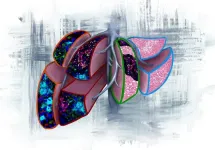(Press-News.org) A new model developed by researchers could help inform guidelines and improve evidence-based advice on the risks and benefits of fish consumption, especially during pregnancy. In a paper published in The American Journal of Epidemiology, researchers from Brigham and Women’s Hospital, a founding member of Mass General Brigham; Harvard T.H. Chan School of Public Health; University of Rochester Medical Center; and Cornell University present a new framework that takes into account estimated average mercury content in consumed fish, helping weigh the detrimental effects of mercury against the potential benefits of nutrients found in fish. Applying this approach to a fish-eating population in Massachusetts, the team found that, in general, consuming increasing amounts of low mercury-containing fish during pregnancy was beneficial, while consuming more high mercury-containing fish was harmful for neurodevelopment.
“For patients who are seeking guidance about fish consumption, public advisories can be confusing and lead to decreased fish intake,” said senior author Susan Korrick, MD, of the Brigham’s Channing Division of Network Medicine and Division of Pulmonary and Critical Care Medicine. Korrick is also a member of the Harvard Chan-NIEHS Center for Environmental Health.
“Our study finds that eating more fish was generally beneficial for neurodevelopment when pregnant individuals consumed fish containing low levels of mercury but detrimental when individuals consumed fish with the highest average mercury levels. It’s important for people to think about what kind of fish they are consuming rather than simply cutting down on fish intake entirely,” said lead author Sally Thurston, PhD, of the University of Rochester Medical Center.
Methylmercury (MeHg) exposure can lead to neurodevelopmental toxicity. However, many nutrients in fish are beneficial for neurodevelopment, including polyunsaturated fatty acids, selenium, iodine and vitamin D. Many studies examining the relationship between mercury exposure and health outcomes measure mercury based on its accumulation in hair. However, relying on hair samples alone makes it impossible to disentangle the potentially harmful effects of mercury from the beneficial effects of fish intake. For example, eating lots of fish that contain low levels of mercury or very little fish that contains high amounts of mercury could result in the same level of mercury in a hair sample but have different potential health risks. Results from analyses that use common statistical approaches to this issue can be challenging to interpret. To address these limitations, the researchers proposed a new model in which they considered the estimated average mercury content of the consumed fish. The team looked at data from participants in the New Bedford Cohort (NBC), a study that has followed 788 children of mothers living near the New Bedford Harbor Superfund site in Massachusetts. In addition to studying hair samples, the team used survey data from a food frequency questionnaire that mothers completed approximately 10 days after giving birth. Participants filled out details about the different types of fish they consumed during pregnancy.
The researchers looked at the relationship between fish consumption—broken out into low-, medium- and high-average fish mercury—and neurodevelopment among the children in the cohort. The team measured neurodevelopment based on tests of IQ, language, memory, and attention. For children whose mothers consumed more fish in the lowest mercury category, fish intake was positively (beneficially) associated with neurodevelopmental outcomes; conversely, for children whose mothers consumed fish with the highest mercury levels, the association between fish intake and neurodevelopmental outcomes was negative (detrimental).
The authors note several limitations to the study, including that estimates of mercury in fish as well as survey measures of diet are imperfect. The study’s population included only participants in the New Bedford area and looked only at neurodevelopmental outcomes. The study also does not account for variation in the beneficial nutrients in the fish consumed such as PUFA or selenium content.
“Our goal is for our study to help facilitate better estimation of the risk-benefit tradeoffs of fish consumption, a key component of many healthy diets,” said senior author Susan Korrick, MD, of the Brigham’s Channing Division of Network Medicine and Division of Pulmonary and Critical Care Medicine. The team hopes that future work will expand on this modeling approach, taking both the average mercury and nutritional content of fish into account.
The authors are in the process of applying this model to other large studies of maternal fish consumption, including the Seychelles Child Development Study, which Thurston serves on as an investigator.
Authorship: The authors of this study are Sally W. Thurston (University of Rochester Medical Center), David Ruppert (Cornell University) and Susan A. Korrick (Brigham and Women’s Hospital and Harvard T.H. Chan School of Public Health).
Funding: This research was funded by the National Institute of Environmental Health Sciences/National Institutes of Health (NIEHS/NIH) grant numbers P42ES005947, R01ES014864, P30ES000002, and P30ES001247.
Paper cited: Thurston SW et al. “A Novel Approach to Assessing the Joint Effects of Mercury and Fish Consumption on Neurodevelopment in the New Bedford Cohort” American Journal of Epidemiology DOI: 10.1093/aje/kwae149
###
END
Engaging in meaningful social interactions with peers is associated with lower loneliness and greater affective well-being, new research finds. Researchers followed three cohorts of university students over three years, collecting data on their social interactions and momentary well-being.
Prior research has focused on the impacts of social interactions and the contexts in which interactions occur, such as places and activities. However, the new research specifically examines the impact of meaningful interactions on well-being. “Our research indicates that engaging in meaningful social interactions have net positive outcomes for affective well-being, stress, and loneliness,” ...
South Korean researchers have successfully developed technology to mass-produce quantum dot lasers, widely used in data centers and quantum communications. This breakthrough paves the way for reducing the production cost of semiconductor lasers to one-sixth of the current cost.
Electronics and Telecommunications Research Institute (ETRI) announced that they have developed, for the first time in Korea, technology to mass-produce quantum dot lasers, previously only used for research, using Metal-Organic Chemical Vapor Deposition (MOCVD) systems.
The ETRI Optical Communication Components Research Section has successfully developed indium arsenide/gallium ...
TAMPA, Fla. (June 28, 2024) -- An interdisciplinary study led by researchers at the University of South Florida and Indiana University has uncovered significant findings on the long-term effects of one of the most common forms of chemotherapy on cancer survivors.
Published in the Journal of the American Medical Association Oncology, the study tracked a cohort of testicular cancer survivors who received cisplatin-based chemotherapy for an average of 14 years, revealing that 78% experience significant difficulties in everyday listening situations, negatively impacting their quality of life. This collaborative research is the first to measure real-world listening challenges and hearing ...
Artificial intelligence models often play a role in medical diagnoses, especially when it comes to analyzing images such as X-rays. However, studies have found that these models don’t always perform well across all demographic groups, usually faring worse on women and people of color.
These models have also been shown to develop some surprising abilities. In 2022, MIT researchers reported that AI models can make accurate predictions about a patient’s race from their chest X-rays — something that the most skilled radiologists can’t do.
That research team has now found that the models that are most accurate at making demographic predictions ...
In brief:
For the first time, researchers use seismic data to estimate a global meteorite impact rate showing meteoroids the size of a basketball impact Mars on a near daily basis.
Impact-generated seismic signals show meteorite impacts to be 5-times more abundant than previously thought.
Seismic data offers a new tool, in addition to observational data, for calculating meteorite impact rates and planning future Mars missions
An international team of researchers, co-lead by ETH Zurich and Imperial College London, have derived the first estimate of global meteorite impacts on Mars using seismic data. Their findings indicate between 280 to 360 meteorites strike ...
When Michael Pirovolakis received an individualized gene therapy in a single-patient clinical trial at The Hospital for Sick Children (SickKids) in March 2022, the course of his condition was dramatically altered.
Michael has spastic paraplegia type 50 (SPG50), an “ultra-rare” progressive neurodegenerative disorder that causes developmental delays, speech impairment, seizures, a progressive paralysis of all four limbs, and typically fatal by adulthood. Approximately 80 children around the world ...
Researchers at Weill Cornell Medicine with an international team have used liver biopsies to identify cellular and molecular markers that can potentially be used to predict whether and when pancreatic cancer will spread to an individual’s liver or elsewhere, such as the lung.
The study, published on June 28 in Nature Medicine, proposes that information from a liver biopsy—a small tissue sample collected for lab analysis—when pancreatic cancer is diagnosed may help guide doctors in personalizing treatment, such as liver-directed immunotherapies, before cancer cells have the chance to metastasize.
Only 10 percent of people with pancreatic ...
A study led by a UC Riverside atmospheric scientist predicts that unchecked carbon emissions will force tropical rains to shift northward in the coming decades, which would profoundly impact agriculture and economies near the Earth's equator.
The northward rain shift would be caused by complex changes in the atmosphere spurred by carbon emissions that influence the formation of the intertropical convergence zones. Those zones are essentially atmospheric engines that drive about a third of the world’s precipitation, Liu and his co-authors report in a paper published Friday, June 28, in the journal Nature Climate Change.
Tropical ...
LOS ANGELES — Physician scientists from City of Hope, one of the largest cancer research and treatment organizations in the United States, found that people with metastatic kidney cancer who orally took a live biotherapeutic product called CBM588 while in treatment with immunotherapy and enzymatic tyrosine kinase inhibitors experienced improved health outcomes. The phase 1 trial was published today in Nature Medicine.
Microorganisms in the gut modulate the immune system. City of Hope researchers are now in discussions with the global SWOG Cancer ...
Seismic signals have suggested Mars gets hit by around 300 basketball-sized meteorites every year, providing a new tool for dating planetary surfaces.
The new research, led by scientists at Imperial College London and ETH Zurich working as part of NASA's InSight mission, has shed light on how often ‘marsquakes’ caused by meteorite impacts occur on Mars.
The researchers found that Mars experiences around 280 to 360 meteorite impacts every year that produce craters larger than eight metres in diameter and shake the red planet’s ...






